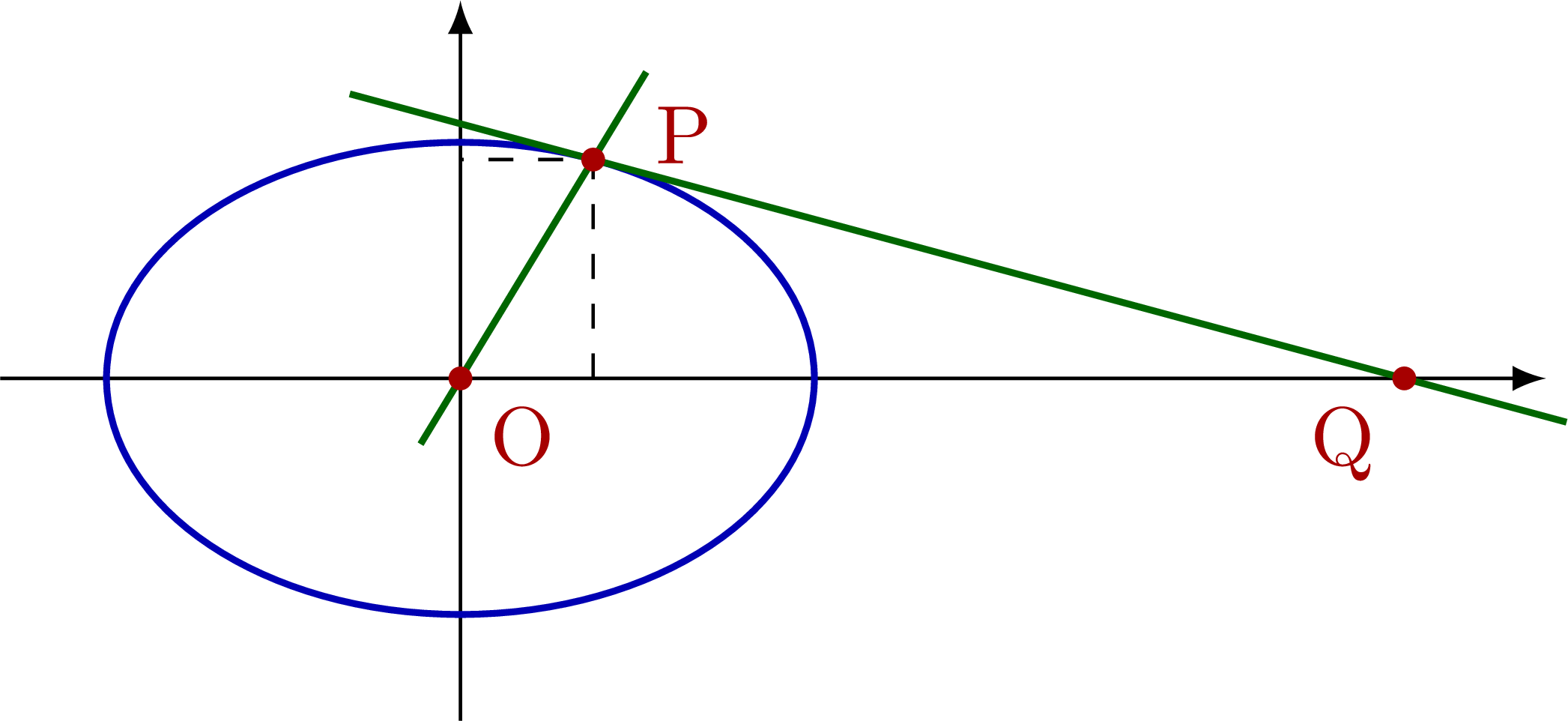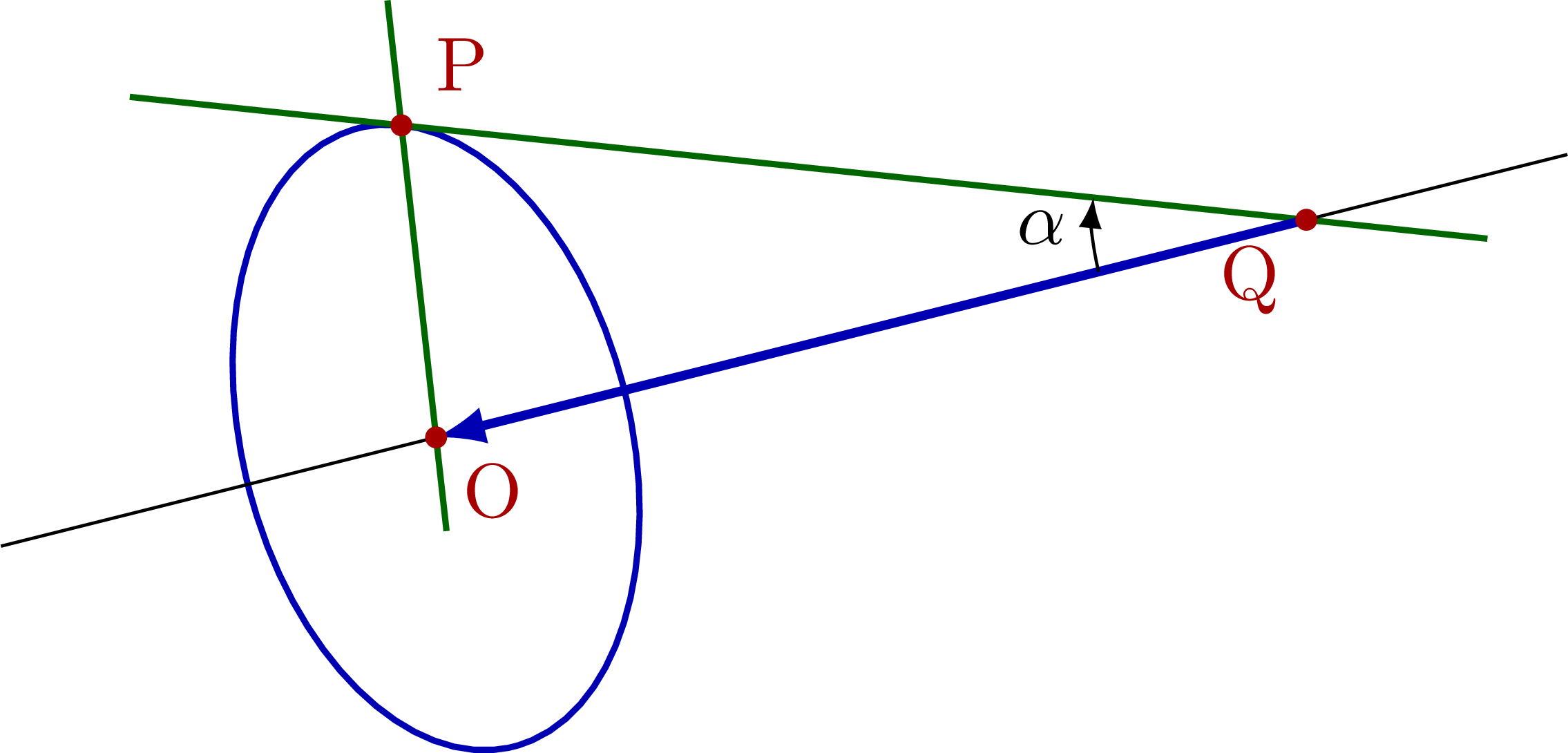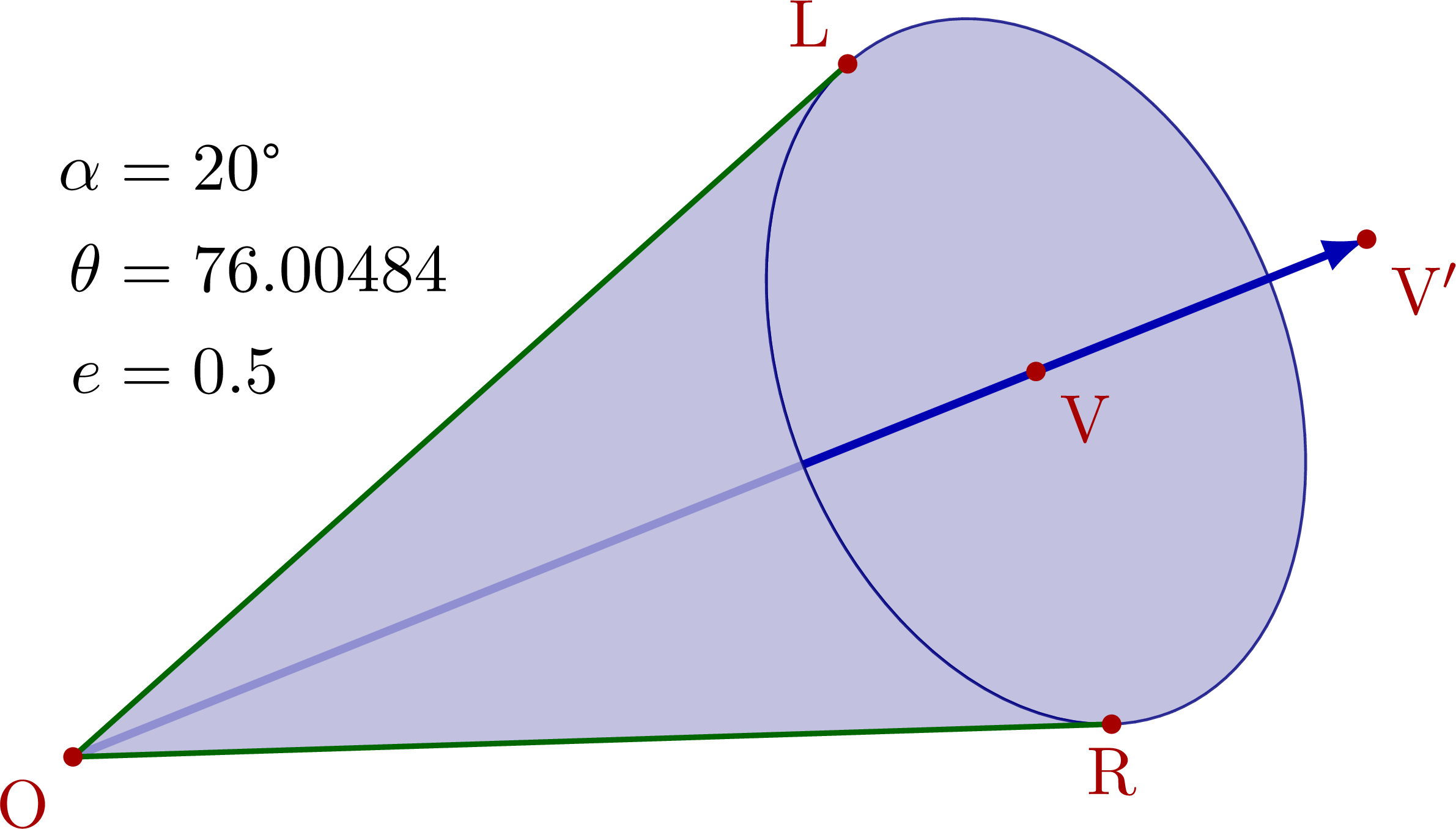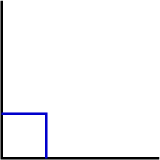Playing around with some methods to create a tangent to a circle of ellipse. Used to create cones in some jet figures.
Known radius r (or a, b) & distance q = |OQ|
% TANGENT to CIRCLE - known: r, q
\usetikzlibrary{calc}
\begin{tikzpicture}
\def\r{1.5} % radius
\def\q{4} % distance center-external point q = |OQ|
\def\x{{\r^2/\q}} % Q x coordinate
\def\y{{\r*sqrt(1-(\r/\q)^2}} % Q y coordinate
\coordinate (O) at (0,0); % circle center O
\coordinate (Q) at (\q,0); % external point Q
\coordinate (P) at (\x,\y); % point of tangency, P
\draw[->] (0,-1.3*\r) -- (0,1.5*\r);
\draw[->] (-1.3*\r,0) -- (\q+0.4*\r,0);
\draw[dashed] (\x,0) |- (0,\y);
\draw[blue,thick] (O) circle(\r);
\draw[green,thick] ($(Q)!-0.2!(P)$) -- ($(Q)!1.3!(P)$);
\draw[green,thick] ($(O)!-0.3!(P)$) -- ($(O)!1.4!(P)$);
\fill[red] (O) circle(0.05) node[below right] {O};
\fill[red] (Q) circle(0.05) node[below left] {Q};
\fill[red] (P) circle(0.05) node[above=3,right=4] {P};
\end{tikzpicture}
% TANGENT to ELLIPSE - known: a, b, q
\begin{tikzpicture}
\def\a{1.5} % horizontal radius
\def\b{1.0} % vertical radius
\def\q{4} % distance center-external point q = |OQ|
\def\x{{\a^2/\q}} % x coordinate P
\def\y{{\b*sqrt(1-(\a/\q)^2}} % y coordinate P
\coordinate (O) at (0,0); % circle center O
\coordinate (Q) at (\q,0); % external point Q
\coordinate (P) at (\x,\y); % point of tangency, P
\draw[->] (0,-\b-0.3*\a) -- (0,\b+0.4*\a);
\draw[->] (-1.3*\a,0) -- (\q+0.4*\a,0);
\draw[dashed] (\x,0) |- (0,\y);
\draw[blue,thick] (O) ellipse({\a} and {\b});
\draw[green,thick] ($(Q)!-0.2!(P)$) -- ($(Q)!1.3!(P)$);
\draw[green,thick] ($(O)!-0.3!(P)$) -- ($(O)!1.4!(P)$);
\fill[red] (O) circle(0.05) node[below right] {O};
\fill[red] (Q) circle(0.05) node[below left] {Q};
\fill[red] (P) circle(0.05) node[above=3,right=4] {P};
\end{tikzpicture}
Known radius r (or a, b) & angle α
% TANGENT to CIRCLE - known: r, alpha
\usetikzlibrary{calc}
\usetikzlibrary{math} % for \tikzmath
\usetikzlibrary{angles,quotes} % for pic (angle labels)
\begin{tikzpicture}
\def\r{1.5} % radius
\def\ang{25} % alpha angle
\def\q{\r/sin(\ang)} % distance center-external point q = |OQ|
\coordinate (O) at (0,0); % circle center O
\coordinate (Q) at ({\q},0); % external point Q
\coordinate (P) at (90-\ang:\r); % point of tangency, P
\draw[->] (0,-1.3*\r) -- (0,1.5*\r);
\draw[->] (-1.3*\r,0) -- ({\q+0.4*\r},0);
\draw[dashed] ({\r*sin(\ang)},0) |- (0,{\r*cos(\ang)});
\draw[blue,thick] (O) circle(\r);
\draw[green,thick] ($(Q)!-0.2!(P)$) -- ($(Q)!1.3!(P)$);
\draw[green,thick] ($(O)!-0.3!(P)$) -- ($(O)!1.4!(P)$);
\fill[red] (O) circle(0.05) node[below right] {O};
\fill[red] (Q) circle(0.05) node[below left] {Q};
\fill[red] (P) circle(0.05) node[above=3,right=4] {P};
\draw pic[<-,"$\alpha$"{above=1,left=0},draw=black,angle radius=28,angle eccentricity=1.0]
{angle = P--Q--O};
\end{tikzpicture}
% TANGENT to ELLIPSE - known: a, b, alpha
\begin{tikzpicture}
\def\a{1.5} % horizontal radius
\def\b{1.0} % vertical radius
\def\ang{25} % alpha angle
\def\q{\a/sin(\ang)} % distance center-external point q = |OQ|
\coordinate (O) at (0,0); % circle center O
\coordinate (Q) at ({\q},0); % external point Q
\coordinate (P) at (90-\ang:{\a} and {\b}); % point of tangency, P
\draw[->] (0,-\b-0.3*\a) -- (0,\b+0.5*\a);
\draw[->] (-1.3*\a,0) -- ({\q+0.4*\a},0);
\draw[dashed] ({\a*sin(\ang)},0) |- (0,{\b*cos(\ang)});
\draw[blue,thick] (O) ellipse({\a} and {\b});
\draw[green,thick] ($(Q)!-0.2!(P)$) -- ($(Q)!1.3!(P)$);
\draw[green,thick] ($(O)!-0.3!(P)$) -- ($(O)!1.4!(P)$);
\fill[red] (O) circle(0.05) node[below right] {O};
\fill[red] (Q) circle(0.05) node[below left] {Q};
\fill[red] (P) circle(0.05) node[above=3,right=4] {P};
\draw pic[<-,"$\alpha$"{above=1,left=0},draw=black,angle radius=28,angle eccentricity=1.0]
{angle = P--Q--O};
\end{tikzpicture}
Known vector & angle α
Cones given by vector and opening angle α
Edit and compile if you like:
% Author: Izaak Neutelings (May 2021)
% Description:
% Experimenting with finding the tangent to an ellipse
% with the purpose of finding a nice way to draw a 3D cone.
\documentclass[border=3pt,tikz]{standalone}
\usepackage{amsmath}
\usepackage{mathtools} % for \eqcolon
\usepackage{physics}
\usepackage{siunitx}
\usepackage{xcolor}
\usepackage{etoolbox} %ifthen
\usepackage[outline]{contour} % glow around text
\usetikzlibrary{calc}
\usetikzlibrary{math} % for \tikzmath
\usetikzlibrary{angles,quotes} % for pic (angle labels)
\tikzset{>=latex} % for LaTeX arrow head
\contourlength{1.6pt}
\colorlet{myblue}{blue!70!black}
\colorlet{mygreen}{green!40!black}
\colorlet{myred}{red!65!black}
\tikzstyle{vector}=[->,very thick,myblue,line cap=round]
\tikzstyle{cone}=[thin,blue!50!black,fill=blue!50!black!30,fill opacity=0.8]
\newcommand\rightAngle[4]{
\pgfmathanglebetweenpoints{\pgfpointanchor{#2}{center}}{\pgfpointanchor{#3}{center}}
\coordinate (tmpRA) at ($(#2)+(\pgfmathresult+45:#4)$);
%\draw[white,line width=0.6] ($(#2)!(tmpRA)!(#1)$) -- (tmpRA) -- ($(#2)!(tmpRA)!(#3)$);
\draw[blue!40!black] ($(#2)!(tmpRA)!(#1)$) -- (tmpRA) -- ($(#2)!(tmpRA)!(#3)$);
}
\begin{document}
% TANGENT to CIRCLE - known: r, q
\begin{tikzpicture}
\def\r{1.5} % radius
\def\q{4} % distance center-external point q = |OQ|
\def\x{{\r^2/\q}} % Q x coordinate
\def\y{{\r*sqrt(1-(\r/\q)^2}} % Q y coordinate
\coordinate (O) at (0,0); % circle center O
\coordinate (Q) at (\q,0); % external point Q
\coordinate (P) at (\x,\y); % point of tangency, P
\draw[->] (0,-1.3*\r) -- (0,1.5*\r);
\draw[->] (-1.3*\r,0) -- (\q+0.4*\r,0);
\draw[dashed] (\x,0) |- (0,\y);
\draw[myblue,thick] (O) circle(\r);
\draw[mygreen,thick] ($(Q)!-0.2!(P)$) -- ($(Q)!1.3!(P)$);
\draw[mygreen,thick] ($(O)!-0.3!(P)$) -- ($(O)!1.4!(P)$);
\rightAngle{Q}{P}{O}{0.40}
\fill[myred] (O) circle(0.05) node[below right] {O};
\fill[myred] (Q) circle(0.05) node[below left] {Q};
\fill[myred] (P) circle(0.05) node[above=3,right=4] {P};
\end{tikzpicture}
% TANGENT to ELLIPSE - known: a, b, q
\begin{tikzpicture}
\def\a{1.5} % horizontal radius
\def\b{1.0} % vertical radius
\def\q{4} % distance center-external point q = |OQ|
\def\x{{\a^2/\q}} % x coordinate P
\def\y{{\b*sqrt(1-(\a/\q)^2}} % y coordinate P
\coordinate (O) at (0,0); % circle center O
\coordinate (Q) at (\q,0); % external point Q
\coordinate (P) at (\x,\y); % point of tangency, P
\draw[->] (0,-\b-0.3*\a) -- (0,\b+0.4*\a);
\draw[->] (-1.3*\a,0) -- (\q+0.4*\a,0);
\draw[dashed] (\x,0) |- (0,\y);
\draw[myblue,thick] (O) ellipse({\a} and {\b});
\draw[mygreen,thick] ($(Q)!-0.2!(P)$) -- ($(Q)!1.3!(P)$);
\draw[mygreen,thick] ($(O)!-0.3!(P)$) -- ($(O)!1.4!(P)$);
\fill[myred] (O) circle(0.05) node[below right] {O};
\fill[myred] (Q) circle(0.05) node[below left] {Q};
\fill[myred] (P) circle(0.05) node[above=3,right=4] {P};
\end{tikzpicture}
% EQUATIONS, known: r (or a, b), q
\begin{tikzpicture}[scale=1]
\node[align=left] at (0,0) {
Circle with radius $r$:\\[2mm]$\quad
\begin{aligned}
\abs{\mathrm{OQ}} &\eqqcolon q \\
\abs{\mathrm{PQ}} &= \sqrt{q^2-r^2} \\
\sin{\alpha} &= \frac{r}{q} \\
\mathrm{P} &= \left( \frac{r^2}{q}, r\sqrt{1-\frac{r^2}{q^2}} \right) \\
\end{aligned}$\\[6mm]
Ellipse with horizontal radius $a$ and vertical radius $b$:\\[2mm]$\quad
\begin{aligned}
\abs{\mathrm{OQ}} &\eqqcolon q \\
\abs{\mathrm{PQ}} &= \sqrt{\left(q^2+b^2-a^2\right)\left(1-\frac{a^2}{q^2}\right) } \\
\sin{\alpha} &= \frac{a}{q} \\
\mathrm{P} &= \left( \frac{a^2}{q}, b\sqrt{1-\frac{a^2}{q^2}} \right) \\
\end{aligned}$};
\end{tikzpicture}
% TANGENT to CIRCLE - known: r, alpha
\begin{tikzpicture}
\def\r{1.5} % radius
\def\ang{25} % alpha angle
\def\q{\r/sin(\ang)} % distance center-external point q = |OQ|
\coordinate (O) at (0,0); % circle center O
\coordinate (Q) at ({\q},0); % external point Q
\coordinate (P) at (90-\ang:\r); % point of tangency, P
\draw[->] (0,-1.3*\r) -- (0,1.5*\r);
\draw[->] (-1.3*\r,0) -- ({\q+0.4*\r},0);
\draw[dashed] ({\r*sin(\ang)},0) |- (0,{\r*cos(\ang)});
\draw[myblue,thick] (O) circle(\r);
\draw[mygreen,thick] ($(Q)!-0.2!(P)$) -- ($(Q)!1.3!(P)$);
\draw[mygreen,thick] ($(O)!-0.3!(P)$) -- ($(O)!1.4!(P)$);
\rightAngle{Q}{P}{O}{0.40}
\fill[myred] (O) circle(0.05) node[below right] {O};
\fill[myred] (Q) circle(0.05) node[below left] {Q};
\fill[myred] (P) circle(0.05) node[above=3,right=4] {P};
\draw pic[<-,"$\alpha$"{above=1,left=0},draw=black,angle radius=28,angle eccentricity=1.0]
{angle = P--Q--O};
\end{tikzpicture}
% TANGENT to ELLIPSE - known: a, b, alpha
\foreach \b in {1.0,2.0}{ % vertical radius
\foreach \ang in {25}{ % alpha angle
\begin{tikzpicture}
\def\a{1.5} % horizontal radius
%\def\b{1.0} % vertical radius
%\def\ang{25} % alpha angle
\def\q{\a/sin(\ang)} % distance center-external point q = |OQ|
\coordinate (O) at (0,0); % circle center O
\coordinate (Q) at ({\q},0); % external point Q
\coordinate (P) at (90-\ang:{\a} and {\b}); % point of tangency, P
\draw[->] (0,-\b-0.3*\a) -- (0,\b+0.5*\a);
\draw[->] (-1.3*\a,0) -- ({\q+0.4*\a},0);
\draw[dashed] ({\a*sin(\ang)},0) |- (0,{\b*cos(\ang)});
\draw[myblue,thick] (O) ellipse({\a} and {\b});
\draw[mygreen,thick] ($(Q)!-0.2!(P)$) -- ($(Q)!1.3!(P)$);
\draw[mygreen,thick] ($(O)!-0.3!(P)$) -- ($(O)!1.4!(P)$);
\fill[myred] (O) circle(0.05) node[below right] {O};
\fill[myred] (Q) circle(0.05) node[below left] {Q};
\fill[myred] (P) circle(0.05) node[above=3,right=4] {P};
\draw pic[<-,"$\alpha$"{above=1,left=0},draw=black,angle radius=28,angle eccentricity=1.0]
{angle = P--Q--O};
\node[right,align=left] at ({0.85*\q},\b+0.6)
{$\begin{aligned}
a &= \a\\
b &= \b\\
\alpha &= \SI{\ang}{\degree}
\end{aligned}$};
\end{tikzpicture}
}}
% EQUATIONS, known: r (or a, b), alpha
\begin{tikzpicture}[scale=1]
\node[align=left] at (0,0) {
Circle with radius $r$:\\[2mm]$\quad
\begin{aligned}
\abs{\mathrm{OQ}} &= \frac{r}{\sin\alpha} \\
\abs{\mathrm{PQ}} &= r\abs{\cot\alpha} \\
\mathrm{P} &= (r;90-\alpha) = (r\sin\alpha,r\cos\alpha) \\
\end{aligned}$\\[6mm]
Ellipse with horizontal radius $a$ and vertical radius $b$:\\[2mm]$\quad
\begin{aligned}
\abs{\mathrm{OQ}} &= \frac{a}{\sin\alpha} \\
\abs{\mathrm{PQ}} &= \sqrt{\frac{a^2}{\sin^2\alpha}+b^2-a^2}\abs{\cos\alpha} \\
\mathrm{P} &= (a\sin\alpha,b\cos\alpha) \\
\end{aligned}$};
\end{tikzpicture}
% TANGENT to CIRCLE - known: vector, alpha
\begin{tikzpicture}
\def\ang{20} % alpha angle
\coordinate (O) at (0,0); % circle center O
\coordinate (Q) at (4,1); % external point Q
\tikzmath{
coordinate \v;
\v = (O)-(Q);
\r = veclen(\vx,\vy)*sin(\ang);
}
\pgfmathanglebetweenpoints{\pgfpointanchor{Q}{center}}{\pgfpointanchor{O}{center}}
\edef\vecang{\pgfmathresult}
\coordinate (P) at ($(O)+({\vecang-(90+\ang)}:\r pt)$); % point of tangency, P
\draw[myblue,thick] (O) circle(\r pt);
\draw[mygreen,thick] ($(Q)!-0.2!(P)$) -- ($(Q)!1.3!(P)$);
\draw[mygreen,thick] ($(O)!-0.3!(P)$) -- ($(O)!1.4!(P)$);
\draw ($(O)!-0.5!(Q)$) -- ($(O)!1.3!(Q)$);
\draw[vector] (Q) -- (O);
\rightAngle{Q}{P}{O}{0.40}
\fill[myred] (O) circle(0.05) node[below right] {O};
\fill[myred] (Q) circle(0.05) node[below left] {Q};
\fill[myred] (P) circle(0.05) node[above right=1] {P};
\draw pic[<-,"$\alpha$"{above=1,left=0},draw=black,angle radius=28,angle eccentricity=1.0]
{angle = P--Q--O};
\end{tikzpicture}
% TANGENT to ELLIPSE - known: vector, angle, a/b
\begin{tikzpicture}
\def\ang{20} % alpha angle
\def\e{0.4} % x scale
\coordinate (O) at (0,0); % circle center O
\coordinate (Q) at (4,1); % external point Q
\pgfmathanglebetweenpoints{\pgfpointanchor{Q}{center}}{\pgfpointanchor{O}{center}}
\edef\vecang{\pgfmathresult} % angle of vector QO
\tikzmath{
coordinate \v;
\v = (O)-(Q);
\x = veclen(\vx,\vy)*\e*sin(\ang)^2; % x coordinate P
\y = tan(\ang)*(veclen(\vx,\vy)-\x); % y coordinate P
\a = veclen(\vx,\vy)*sqrt(\e)*sin(\ang); % vertical radius
\b = veclen(\vx,\vy)*tan(\ang)*sqrt(1-\e*sin(\ang)^2); % horizontal radius
}
\coordinate (P) at ($(O)+(\vecang-180:\x pt)+(\vecang-90:\y pt)$); % point of tangency, P
\draw[myblue,thick,rotate=\vecang] (O) ellipse({\a pt} and {\b pt});
\draw[mygreen,thick] ($(Q)!-0.2!(P)$) -- ($(Q)!1.3!(P)$);
\draw[mygreen,thick] ($(O)!-0.3!(P)$) -- ($(O)!1.4!(P)$);
\draw ($(O)!-0.5!(Q)$) -- ($(O)!1.3!(Q)$);
\draw[vector] (Q) -- (O);
\fill[myred] (O) circle(0.05) node[below right] {O};
\fill[myred] (Q) circle(0.05) node[below left] {Q};
\fill[myred] (P) circle(0.05) node[above right=1] {P};
\draw pic[<-,"$\alpha$"{above=1,left=0},draw=black,angle radius=28,angle eccentricity=1.0]
{angle = P--Q--O};
\end{tikzpicture}
% CONE
\foreach \ang in {10,20}{ % alpha angle
\foreach \e in {0.05,0.5}{ % x scale
\begin{tikzpicture}
%\def\ang{10} % alpha angle
%\def\e{0.3} % x scale
\coordinate (O) at (0,0);
\coordinate (V) at (5,2);
\pgfmathanglebetweenpoints{\pgfpointanchor{O}{center}}{\pgfpointanchor{V}{center}}
\edef\vecang{\pgfmathresult} % angle of vector OV
\tikzmath{
coordinate \v;
\v = (O)-(V);
\x = veclen(\vx,\vy)*\e*sin(\ang)^2; % x coordinate P
\y = tan(\ang)*(veclen(\vx,\vy)-\x); % y coordinate P
\a = veclen(\vx,\vy)*sqrt(\e)*sin(\ang); % vertical radius
\b = veclen(\vx,\vy)*tan(\ang)*sqrt(1-\e*sin(\ang)^2); % horizontal radius
\angb = acos(sqrt(\e)*sin(\ang)); % angle of P in ellipse
}
\coordinate (V') at ($(V)+(\vecang:1.15*\a pt + 10 pt)$); %($(O)!{1/cos(\ang)^2}!(V)$);
\coordinate (R) at ($(V)+(\vecang-180:\x pt)+(\vecang-90:\y pt)$); % tangency
\coordinate (L) at ($(V)+(\vecang-180:\x pt)+(\vecang+90:\y pt)$); % tangency
%\coordinate (R') at ($(V)+(\vecang-90:\b pt)$); % tangency
%\coordinate (L') at ($(V)+(\vecang+90:\b pt)$); % tangency
\draw[cone,rotate=\vecang]
(V) ellipse({\a pt} and {\b pt});
\draw[vector] (O) -- (V');
\draw[cone,rotate=\vecang]
(L) arc(180-\angb:180+\angb:{\a pt} and {\b pt}) -- (O) -- cycle;
\draw[mygreen,thick] (O) -- (L);
\draw[mygreen,thick] (O) -- (R);
\fill[myred] (O) circle(0.05) node[below left] {O};
\fill[myred] (V) circle(0.05) node[below right] {V};
\fill[myred] (V') circle(0.05) node[below right] {V$'$};
\fill[myred] (L) circle(0.05) node[above left=-1] {L};
\fill[myred] (R) circle(0.05) node[below=0] {R};
%\fill[myred] (L') circle(0.05) node[above right=-1] {L$'$};
%\fill[myred] (R') circle(0.05) node[below right] {R$'$};
\node[right,align=left] at (-0.2,2.5) {$\begin{aligned}
\alpha &= \SI{\ang}{\degree} \\
\theta &= \angb \\
e &= \e
\end{aligned}$};
\end{tikzpicture}
}}
\end{document}Click to download: circle_tangent.tex • circle_tangent.pdf
Open in Overleaf: circle_tangent.tex



















FYI, I tried compiling this code in overleaf as well as my local installation (This is pdfTeX, Version 3.141592653-2.6-1.40.26 (TeX Live 2024) (preloaded format=pdflatex))
I get this error message
The compiler is having trouble understanding a command you have used. Check that the command is spelled correctly. If the command is part of a package, make sure you have included the package in your preamble using \usepackage{…}.
Learn more
\C ->\ERROR
l.190 }
The control sequence at the end of the top line
of your error message was never \def’ed. If you have
misspelled it (e.g., `\hobx’), type `I’ and the correct
spelling (e.g., `I\hbox’). Otherwise just continue,
and I’ll forget about whatever was undefined.
Hi Troy,
Thanks for reporting this!
I cannot reproduce it on my own local installation (pdfTeX, Version 3.141592653-2.6-1.40.24 via TeX Live 2022), but I can reproduce it on this webpage. I could solve it by simply renaming
\Cin each\tikzmath(and consequently all derived\Cx,\Cy) to whatever else (\c,\foo, …). Not sure why the installation of some compilers choke on\C, but can you try, please? I’ll update the code on this page later.Cheers,
Izaak
Hi Troy,
After playing around with it, I think the issue is caused by the using the
siunitxpackage, which includes a\Cdefinition for Coulomb units. You can try for yourself:\documentclass[border=3pt,tikz]{standalone} %\usepackage{siunitx} % causes conflict with \C for Coulomb \usetikzlibrary{math} % for \tikzmath \begin{document} \begin{tikzpicture} \coordinate (O) at (0,0); \coordinate (R) at (4,2); \tikzmath{ coordinate \C; \C = (R)-(O); \r = veclen(\Cx,\Cy); } \draw[->,blue,very thick] (O) -- (R) node[midway,above left,align=left] {$r=\r$\\$x=$\,\Cx\\$y=$\,\Cy}; \end{tikzpicture} \end{document}I fixed it in the post by replacing
\Cwith\veverywhere.Cheers,
Izaak